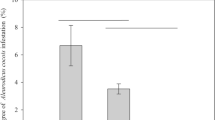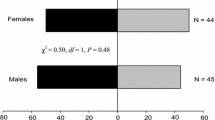Abstract
Apple volatiles stimulated pheromone release, oviposition, and upwind orientation in female codling moths, Cydia pomonella. Green apples increased the percentage of virgin females calling, the duration of female calling, and advanced the onset of egg-laying in gravid females. In a tube olfactometer, both virgin and mated females were more active in the presence of apple volatiles than in clean air. They responded by walking while wing-fanning; mated females showed a stronger attraction response than unmated females.
Similar content being viewed by others
REFERENCES
Batiste, W. C., Olson, W. H., and Berlowitz, A. 1973. Codling moth: influence of temperature and daylight intensity on periodicity of daily flight in the field. J. Econ. Entomol. 66:883-892.
BoevÉ, J.-L., Lengwiler, U., Tollsten, L., Dorn, S., and Turlings, T. C. J. 1996. Volatiles emitted by apple fruitlets infested by larvae of the European apple sawfly. Phytochemistry 42:373-381.
Bradley, S. J., and Suckling, D. M. 1995. Factors influencing codling moth larval response to α-farnesene. Entomol. Exp. Appl. 75:221-227.
Castrovillo, P. J., and CardÉ, R. T. 1979. Environmental regulation of female calling and male response periodicities in the codling moth (Lespeyresia pomonella). J. Insect Physiol. 25:659-667.
Chapman, P. J. 1973. Bionomics of apple-feeding Tortricidae. Annu. Rev. Entomol. 18:73-96.
Curtis, C. E., Tebbets, J. S., and Clark, J. D. 1990. Ovipositional behavior of the codling moth (Lepidoptera: Tortricidae) on stone fruits in the field and an improved oviposition cage for use in the laboratory. J. Econ. Entomol. 83:131-134.
DeseÖ, K. V. 1972. The role of farnesylmethyl-ether applied on males influencing the oviposition of the female codling moth (Laspeyresia pomonella L., Lepid., Tortricidae). Acta Phytopathol. Hung. 7:257-266.
Flath, R. A., Black, D. R., Forrey, R. R., McDonald, G. M., Mon, T. R., and Teranishi, R. 1969. Volatiles in gravenstein apple essence identified by gas chromatography-mass spectrometry. J. Chromatogr. Sci. 7:508-512.
Gehring, R. D., and Madsen, H. F. 1963. Some aspects of mating and oviposition behavior of the codling moth, Carpocapsa pomonella. J. Econ. Entomol. 56:140-143.
Geier, P. 1963. The life history of codling moth Cydia pomonella (L.) (Lepidoptera, Tortricidae) in the Australia capital territory. Aust. J. Zool. 11:323-367.
Hendrikse, A., and Vos-BÜnnemeyer, E. 1987. Role of host-plant stimuli in sexual behaviour of the small ermine moths (Yponomeuta). Ecol. Entomol. 12:363-371.
Jackson, D. M. 1979. Codling moth egg distribution on undamaged apple trees. Ann. Entomol. Soc. Am. 72:361-368.
Landolt, P. J., and Philips, T. W. 1997. Host plant influences on sex pheromone behavior of phytophagous insects. Annu. Rev. Entomol. 42:371-391.
Mani, E., Riggenbach, W., and Mendik, M. 1978. Zucht des Apfelwicklers (Lasperyesia pomonella L.) auf künstlichem Nährboden, 1968–1978. Mitt. Schweiz. Entomol. Ges. 51:315-326.
Mattheis, J. P., Fellman, J. K., Chen, P. M., and Patterson, M. E. 1991. Changes in headspace volatiles during physiological development of bisbee delicious apple fruit. J. Agric. Food Chem. 39:1902-1906.
McNeil, J. N., and Delisle, J. 1989. Are host plants important in pheromone-mediated mating systems of Lepidoptera? Experientia 45:236-240.
Minks, A. K. 1996. Mating disruption of the codling moth, pp. 372-376, in R. T. Cardé and A. K. Minks (eds.). Insect Pheromone Research—New Directions. Chapman and Hall, New York.
Raina, A. K. 1988. Selected factors influencing neurohormonal regulation of sex pheromone production in Heliothis species. J. Chem. Ecol. 14:2063-2069.
Riedl, H., and Loher, W. 1980. Circadian control of oviposition in the codling moth, Laspeyresia pomonella, Lepidoptera: Olethreutidae. Entomol. Exp. Appl. 27:38-49.
Robert, P. C. 1986. Les relations plantes-insectes phytophages chez les femelles pondeuses: Le rôle des stimulus chimiques et physiques. Une mise au point bibliographique. Agronomie 6:127-142.
Sutherland, O. R. W., Hutchins, R. F. N., and Wearing, C. H. 1974. The role of the hydrocarbon α-farnesene in the behaviour of codling moth larvae and adults, pp. 249-263, in L. M. Brown (ed.). Experimental Analysis of Insect Behaviour. Springer-Verlag, Berlin.
Trimble, R. M. 1995. Mating disruption for controlling the codling moth, Cydia pomonella (L.) (Lepidoptera: Tortricidae), in organic apple production in southwestern Ontario. Can. Entomol. 127:493-505.
Wearing, C. H., and Hutchins, R. F. N. 1973. α-Farnesene, a naturally occurring oviposition stimulant for the codling moth, Laspeyresia pomonella. J. Insect Physiol. 19:1251-1256.
Wearing, C. H., Connor, P. J., and Ambler, K. D. 1973. Olfactory stimulation of oviposition and flight activity of the codling moth Lespeyresia pomonella, using apples in an automated olfactometer. N.Z. J. Sci. 16:697-710.
Weissling, T. J., and Knight, A. L. 1996. Oviposition and calling behavior of codling moth (Lepidoptera: Tortricidae) in the presence of codlemone. Ann. Entomol. Soc. Am. 89:142-147.
White, L. D., Hutt, R. D., and Butt, B. A. 1973. Field dispersal of laboratory-reared fertile female codling moths and population suppression by release of sterile males. Environ. Entomol. 2:66-69.
Wildbolz, T. 1958. Über die Orientierung des Apfelwicklers bei der Eiablage. Mitt. Schweiz. Entomol. Ges. 31:25-34.
Witzgall, P. and Arn, H. 1997. Technology transfer in mating disruption. IOBC wprs Bull. 20:1-301.
Yahia, E. M., Acree, T. E., and Liu, F. W. 1990. The evolution of some odour-active volatiles during the maturation and ripening of apples on the tree. Lebensm. Wiss. Technol. 23:488-493.
Yokoyama, V. Y., and Miller, G. T. 1991. A plum volatile, 1-nonanol: An ovipositional deterrent for codling moth. Can. Entomol. 123:711-712.
Author information
Authors and Affiliations
Rights and permissions
About this article
Cite this article
Yan, F., Bengtsson, M. & Witzgall, P. Behavioral Response of Female Codling Moths, Cydia pomonella, to Apple Volatiles. J Chem Ecol 25, 1343–1351 (1999). https://doi.org/10.1023/A:1020978826346
Issue Date:
DOI: https://doi.org/10.1023/A:1020978826346




